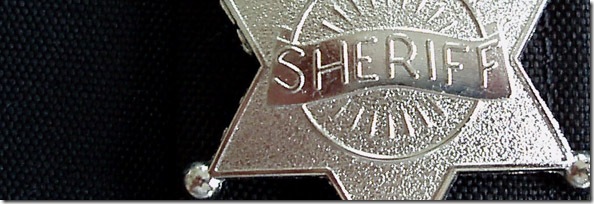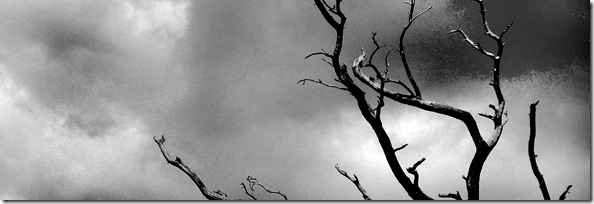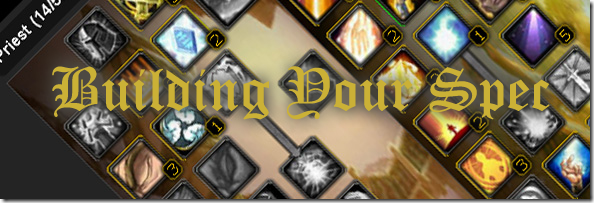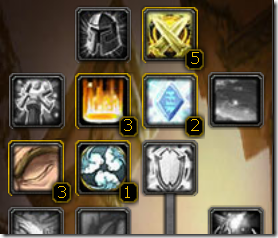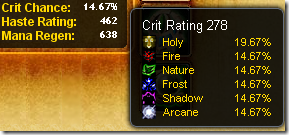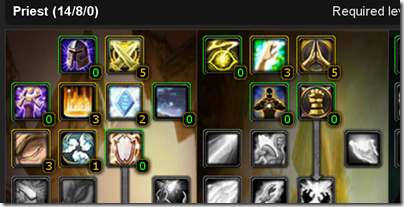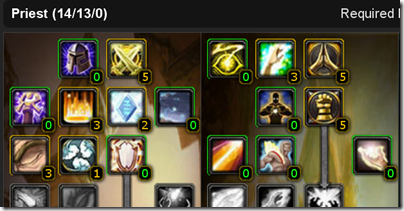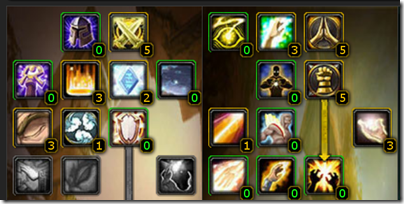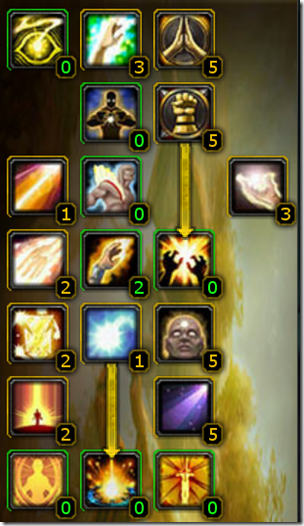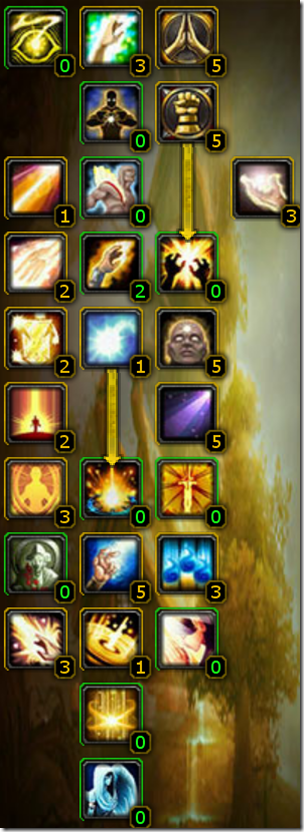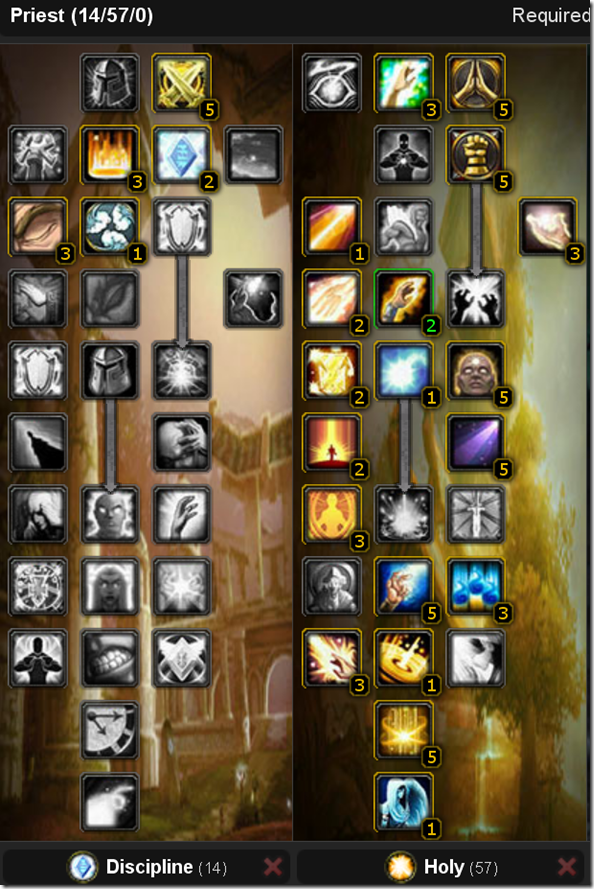
The conflict over healing meters is an old topic, on this blog, the WoW healing forums, the PlusHeal forums, and, for many of you, within your own guilds. While it’s widely accepted that meters are one of the best tools dps players can use to analyze their performance, the usefulness of meters when it comes to healing or tanking has always been in doubt. The official line from Ghostcrawler is that meters can’t tell healers very much about their own effectiveness. The following story is a tidbit taken from a forum topic on Shaman PvE healing. I first read it, however, in a repost on my own guild’s site. It seems that whenever the developers comment on healing meters, people take notice. Ghostcrawler says:
We were talking about healing this very fight [XT hardmode] just yesterday. One of the designers had an interesting experience. Their first Holy priest had much larger healing (total and effective) on the fight than their second Holy priest, so they asked the second priest to go Shadow. They kept wiping. They then swapped them, and made the star Holy priest go Shadow. The second Holy priest’s healing was much lower, but they won on the first try. The second priest just had better timing and cast the right spell at the right moment, even though his total and effective healing was lower overall. The moral of the story is meters are very useful, but like any tool, their ability to measure what happens in reality has limitations. In my experience, players put too much emphasis on them, especially for healing.
I have to say that GC’s Tale of Two Priests seems apocryphal to me. As my guild members pointed out in our website discussion, this is an odd situation that we can’t really imagine in any of our raids. It seems–to us anyway–that there’s not enough information here to judge what really happened. One of my guildies suggested that maybe the “star” Holy Priest was also really good at Shadow, and that seems pretty reasonable to me. However, what’s clear is that Ghostcrawler–who, let’s face it, has more information than you or I do–thinks people put too much emphasis on meters.
The truth of the matter is that healing meters CAN tell you a good number of things about a healer’s overall effectiveness. The trick is learning to read them with a critical eye. In the interest of full disclosure, I’ll tell you that I probably like and use healing meters more than most healing bloggers I read, and certainly more than Ghostcrawler. However, in my own guild, I’m usually in the anti-meters faction. Ironically, our guild’s biggest advocate for healing meters is not himself a healer. There’s no guarantee that a guild’s leadership will be healing-savvy, and the points in this article should help raiding healers enter into an intelligent discussion with even the most determined meter-maid of a raid leader.
In this article, I’m going to go over a few things that healing meters CAN and CANNOT reveal about your guild’s healers. I would never, for example, promote or dismiss a healer from my raiding corps based on meters alone. However, if I were evaluating a new healer, I would expect the different logs to be able to tell me a certain amount of things. At certain points, I’m going to be referring to the combat log parsers I’ve personally used, including WWS, WoW Meter Online, World of Logs, and of course, the ubiquitous Recount. Each of these programs displays the information differently, and some are more nuanced in their presentation than others.
What Meters Reveal

Did you win the meters last night? If you can answer this question, as a healer anyway, you don’t know how to read the meters. In the above screenshot from WoWMeter Online, it might look like Kaldora “beat” Mallet on the meters…until you notice that Mallet is a discipline priest and, as such, his primary ability doesn’t even show. Essentially, when you are looking at any combat log statistics in any form (even scrolling through the log itself), what you are doing is reconstructing the raid from perspectives other than your own. It’s a bit odd, like watching a home movie of yourself. Just like the camera’s lens, the log parser has a limited view of your actions. It collects statistics, and these tend to be fairly accurate, but you have to do the evaluation yourself. I read a combat log parse critically, and the following are the questions that the statistics can help me answer.
1. What were the healing assignments?
As a rule, tank healers place lower on the meter than raid healers. That’s just how it is–unlike dps, who can do infinite damage, a healer can only put out the numbers in response to damage. The more targets, the higher the ceiling. When I look at a breakdown for a particular fight, I can reconstruct the healing leader’s instructions to the raid pretty easily. The “Breakdown” section of WWS or “Who Healed Whom” section of WoWmeteronline will tell you for certain where people spent their time. However, for the most part I can reconstruct who did what just based on percentage of healing done and spell choice. When I have a new recruit in the raid, I use the meters to check if she’s been following instructions.
2. What is a player’s rotation?
If you’re a longtime healer, you might think that you don’t have a rotation. You just do what seems “natural,” right? Healing might seem like a mysterious force that arises out of the aether, but in fact, every healer has a rotation, either explicit or implicit. It only seems that there’s no rotation because you’re not mashing 1-2-3-3-3-3-3-4-4-4-4-4 like a Moonkin would (and let me tell you, the rare times Matticus lets me play laser chicken I need serious help from Squawk and Awe to get the 3’s and 4’s at the right time). Healer rotations are not necessarily set; rather, they are a series of if-then statements. If X kind of damage occurs, the healer casts spell Y. Some healers have a more explicit rotation than others. Druids are the most like dps in that our healing spells set up combos. 3X Lifebloom is a component of a rotation, as is a HoT setup for Nourish. And that 6-second cooldown for Wild Growth or Circle of Healing? That little piece of timing contributes to the development of a rotation for Resto Druids and Holy Priests. I don’t know about the rest of you, but whenever I’m raid healing, I’m watching my Wild Growth cooldown like a hawk. I know the number of casts I can perform before it’s up again. Every single class has something they do pre-emptively. For Healadins, it’s Bacon of Light and Holy Shield. For the Resto Shaman, it’s Riptide.
After long practice, these routines become automatic. The muscles are quite literally faster than the brain, and before you know it, you’ve hit Rejuv-Rejuv-Rejuv-Swiftmend-Wild Growth without once stopping to think about it. My favorite section of the log parsers are the spell breakdowns. On WoWMeterOnline, I particularly appreciate the pie chart of my abilities. I love the fact that I can compare two sets of statistics–the proportion of spells I actually cast (the pie), versus how much effective healing those spells accomplished (the column). This feature lets me amend my rotation. If I’m casting something too much and not getting enough effective healing out of it, I can alter that pattern. I can also compare my spell choice and cast ratios to other Druids. I’m never the best one out there, and I know it. If I think someone put in a stellar performance on a fight, I try to learn from it. If I see a Druid do particularly well in a fight using 15% Nourish, I’ll make a conscious effort to use it the next time.
The following image is the breakdown of my own abilities during a Mimiron fight. From this chart, you can reconstruct my rotation. It appears to be very heavy on Rejuv and Wild Growth, probably during the raid healing portions of the fight, with Lifebloom and Nourish used much less (probably mostly on tank targets in P1 and P4).

Here is the WoWMeterOnline pie chart for a different Mimiron fight. Even pre-4pc bonus, I’m still getting more than my money’s worth for Rejuvenation. It accounted for 23% of my casts but did 38% of my healing. Nourish, on the other hand, is a relative loser, being a fairly large portion of my casts but a fairly small portion of my healing done. To some extent, this is just the nature of the two spells, but on this particular fight, HoTs are king. Rejuv doesn’t look nearly as good on a fight with less predictable AoE damage.

3. Did something go terribly wrong?
If you’re accustomed to reading log parses for your guild, you can start to separate the wipes from the successes. Particularly if a wipe was blamed on healing failure, I urge you to go through the parse for that attempt. For this purpose, I find the death log and the Who Healed Whom? sections to be most useful. If you have a healer who repeatedly dies to the same (avoidable) boss ability, that information may help you improve your healing corps. I find, however, that most healing fails have less to do with healers standing in the fire than with healers deviating from their responsibilities. If you lost a tank on an attempt, go look at what your tank healers were doing. In particular, a little statistic called the Focus is helpful for this. If a tank healer has a high focus, that means they are healing randomly in the raid–i.e. diverting attention from their assigned tank. There are many reasons healers do this, but I’ll tell you, most of them have to do with a desire to look better on the meters. I’ve done it myself–looked away from the tank for one moment because I thought I could–and boy does it feel bad afterwards when that little innocent raid heal causes a wipe.
4. Which healer–allowing for class, spec, and assignment–contributed the most on a particular fight?
This is the moment where you really get to compare. You won’t necessarily be able to do this on every fight. Healing corps tend to shift about a bit, as healer turnover is always pretty high. However, on the occasions where you have two holy priests, you can compare them if and only if they were given the same assignment. If you are a healing lead, and you have a new recruit, try to assign them to the same thing as one of your veterans. This is most useful if you can pair them with the same class, but if that isn’t possible, try to match their role as closely as possible. You won’t get anywhere comparing the numbers of a Resto Shaman and a Resto Druid, even if you assign them both to heal the tank. However, if you assign your Resto Shaman to tank healing, you can compare his or her numbers to a Holy Paladin. It might not tell you much, but at least you can see which one kept a tighter focus on their tank or did more healing on that one target. If you do get the magical situation where you can compare raid-healing Resto Druid to raid-healing Resto Druid, you can actually pick a winner. Try to use your knowledge for good and not evil. If you have a new recruit who has some learning to do, encourage them to adopt spell choices more like your veteran. I do urge you to have several parses before you make your recruit change things. What the parses can’t do on their own is tell WHY one player “won” the meters.
5. How much of a role did heal-sniping play in a particular fight?
Ah, sniping. Whenever someone “loses” the meters and others make a big deal about it, there will be talk of sniping. The rather ugly word “sniping” indicates the practice of sneaking around on one’s healing assignment by spot healing other players. To some extent, sniping is something that can’t be avoided. If players are assigned to raid healing, those assignments have to be loose in order to let healers react to the actual damage that goes on in the fight. Even with mods, it’s sometimes hard to tell which raid members are about to receive a needed heal. As a healing leader, just understand how raid heal sniping works against certain classes. Circle of Healing and Wild Growth, due to their “smart” nature, can’t be kept to a neat assignment. These spells will “steal” some heals from your Resto Shamans. If you know that, you know to calm your shamans down when they’re worried. It’s just something that happens–so don’t demote your Shamans or overly praise your Druids. That’s just how the mechanics work together. Believe me, you need every competent healer you have–a raid is not a game of Survivor. If you want to minimize raid heal sniping, I suggest giving your healers proximity-based assignments. Our Mimiron strategy is a good example–we assign healers to quadrants, and as we’re spread out in a ring for P1, P2, and P4 of the fight, healers can’t reach across the room to snipe from their fellows. However, when you’re all clumped up, snipe happens.
Raid heal sniping tends not to affect the outcome of a fight, but the same cannot be said of sniping while tank healing. Sometimes tank healers need a little support. While a HoT or two from a raid healer on a tank is technically sniping, it’s usually helpful. After all, if the tank dies, you’re done, and extra insurance is not a bad thing. However, when your tank healers sneak heals onto the raid, it’s not always so helpful and it sometimes gets the tank killed. However, in some sense we are set up to do just this. I know that in particular, Holy Priests and Resto Druids can (and sometimes should) sneak a few Circles of Healing or Wild Growths on the raid while they’re tank healing. The trick is to have a realistic sense of how often you can turn away from your focus and for how long. I know the couple of times in my healing career I’ve caused a tank death because I’ve been sniping have been moments of intense shame and regret. If you have weird tank deaths in your raid, go check out healers’ focuses. That should tell you if sniping is the cause.
6. How do the healing classes differ from each other?
Whenever I look through a log parse, I’m struck by just how different the four healing classes are. I especially like to look at players’ spell choice. Some, like Holy Pallies, will show a lot of casts of the same thing, while others, like Holy Priests, will show a variety of abilities. This helps me reconstruct what healing was like in a particular raid. When you’re reading those meters, particularly a simple meter like Recount, you should know that “winning” those meters is linked to class and spec. If I’m looking at Recount, especially one that hasn’t been reset for a certain fight but rather has been running all night, I’m probably going to see either a Resto Druid or Holy Priest on top. That’s just what happens–it doesn’t mean too much. The meter is not a perfect measure. It sees a limited amount of information. It can’t tell you, for example, just how important your Pally’s tank heals were. All it can tell you was that he put out less raw healing than your raid healers. Even on the same assignment, your Resto Shamans, Holy Pallies (unless you have no Ret Pally and your Healadin gets to cast Judgment of Light), and Disc Priests will almost always be lower down. This is just how our spells work together, and it doesn’t make Pallies or Shamans bad. Also, if your raid is melee heavy, you might sometimes see the Ret Pally sneak up the meter with just Judgment of Light. However, this doesn’t mean that you should make your Holy Pally go Ret because Ret’s healing is “better.” Believe me when I say that Judgment of Light alone won’t heal your tank.
Why Do Some Players Place Higher than Others on the Meter?
Even when class, spec, and assignment are the same, players’ numbers will vary. Many people would claim that “skill” determines placement, but it’s only part of the truth. That sort of answer contradicts GC’s anecdote and gives healers a sense that they can’t improve, no matter what they do. However, there are usually resolvable issues that determine effective healing. It’s not all reaction time or “innate” gaming ability! As a 30-year old woman who didn’t grow up playing video games, I wouldn’t stand a chance if it weren’t possible to learn better healing techniques. However, I find myself on the top of the meters from time to time (and also…on the bottom). This wouldn’t happen if it weren’t possible to change my performance through effort.
As a healing lead, I’ve read a lot of meters. In my mind, the following are the most common reasons for meter differences between players.
1. Casting speed. By “casting speed,” I mean the rate at which the player queues up a new spell once the old one casts. This is the magic of reaction time. It’s hard to learn, but faster casting is supported by Quartz, readable raid frames, a faster machine, gear (especially haste), talents, and little things like a Tuskarr’s Vitality enchant to boots. It seems silly but yes, faster running almost always means more time to cast.
2. Talent choices. Sometimes there are many correct builds, but there is usually one best one for certain raid functions. The “best” build can depend on what the person’s role in your raid is. If your recruit will primarily be a raid healer, she might want to adapt her talents to reflect that.
3. Spell choice. What you cast is just as important as how often. There’s no “right” answer, but there are better and worse choices. A heavy use of Nourish with no HoT support is an example of a poor choice. To make intelligent choices, read your blogs and Elitist Jerks and try out different things in raids. If you’re a healing lead trying to diagnose problems, try to find an “ideal” spell cast ratio to suggest to the healer in question from a reliable source. Usually, finding an “expert” in the class to talk to is quickest and easiest. When in doubt, email a blogger! You might just get a whole post in response.
4. Gear, gear, GEAR. I can’t overemphasize what a difference equipment makes. Sure, there are prodigies of healing out there that can outheal me in their Naxx gear. Don’t expect your recruits to be among these magical beings. Amazing reaction time is rare, and it can make up for gear deficits. However, for the rest of us, properly maintained equipment with the right stats, the right gems, and the right enchants is one of the major things we rely on to put in a good performance.
Wrong Ways to Use the Meters
If you’re in charge of a guild or healing corps, please do not indulge in the following meter-related Healing Destructions.
1. Looking exclusively at total healing done for the whole night
I hate it when people post their Recount for a four hour raid. Every fight is different, and many players respec to different roles throughout the night. Moreover, assignments differ from fight to fight. If you’re number 1, try to restrain the need to pat yourself on the back. If you’re number 7, you don’t really need that box of tissues.
2. Looking exclusively at HPS
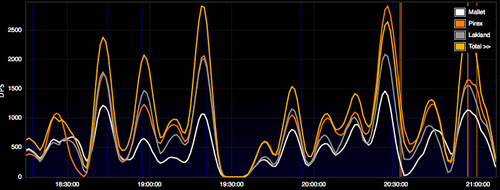
HPS varies wildly by class, assignment, and fight. After all, you need damage to happen before you can heal. Here is a World of Logs chart showing my guild’s healers’ HPS for a whole night. What useful thing can you glean from that? Um, overall HPS is higher when heroism is cast? Big surprise there. If you’re in charge, don’t make your healers paranoid about HPS. They’ll be afraid to CC during trash, and they’ll snipe more during bosses.
3. Comparing apples to oranges
If you’re going to pick “winners” on the meters, make sure you’re looking at the same thing. The values for class, spec, and assignment need to match. Also, be really careful if you’re comparing your guild’s parse to another guild’s. You don’t know how they do things or how good they are. Judging your healers by an arbitrary external standard isn’t necessarily meaningful. For an example of this type, before we killed Vezax, our raid leader was outraged at the healers because we needed Saronite Vapors to stay in mana. He was looking at a parse where almost no one in the raid took damage and where healers used no vapors. It took me about ten minutes of staring at the report of a “better” guild with “better” healers before I realized that all these (failed) attempts were tries at HARD MODE. You have to walk before you can run, people–comparing your guild to the “best” guilds in the world is the Path of Anguish. The reports reconstruct the raid, but they are at best a distorted mirror. If you’re going to look outside the guild for comparisons, try to find a guild that’s similar to yours that’s working on the same goals.
4. Hiring and firing based on the meters
Everyone wants something concrete to rely on when they have to make a tough decision. Just don’t succumb to this pressure. If you have a borderline healer, watch her DURING the raid. I sometimes keep new healers as my focus so I can see what they’re doing. Give your newbie tough assignments and see if people die. These things will be more meaningful than saying: “You’re number 6 on Recount, so you’re out.”
5. Encouraging meter-based competition among your healers
The more the leadership emphasizes meters, the more your healers will respond. No one wants to be voted off the island. Instead of becoming better players, your healers will start ignoring their assignments, sniping, and whining. You really do not want this. Your healers are supposed to be a team.
Conclusions
Yes, healing meters can be useful. If you have access to log parses, you can certainly learn from them. As an individual, you may be able to tweak your performance. However, naive uses of the healing meters can cause mischief and pain. Reading a meter intelligently is a difficult skill to learn, and if you’re in a position of power, it would be in the best interest of your guild if you interpreted the meters as thoughtfully as possible. There’s no magic stat that you can read to tell if someone is good or not.

